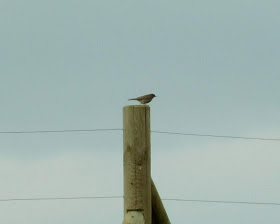This colour-ringed black-tailed godwit BB-RGf was photographed by Andy Field on Monday 30th, as it fed along the Strood Channel with 19 other godwits. The same bird was seen again on Tuesday in the same size of flock. Andy discovered from the black-tailed godwit ringing project, that this bird had just recently returned from spending the winter in the Tagus estuary near Lisbon and was on its way back to its breeding grounds in Iceland.
Also along the Strood on Tuesday 31st were two common buzzards, sparrowhawk, pair of Mediterranean gulls, great crested grebe, singing chiffchaff and a flock of 50 linnets in the field.
Later over Firs Chase a common buzzard and a sparrowhawk were seen over the garden.
Offshore from West Mersea were two great northern divers and an eider seen by Martin Cock on Tuesday.
Four common buzzards were in the air together over the Strood fields on Monday 30th and a corn bunting perched on a bush by the seawall.
This male sparrowhawk was tucking into a collared dove in Andy Field's High St North garden on Sunday 29th. A little egret was seen flying over his garden the next day.
In the Firs Chase garden a pair of goldfinches stopped off briefly, this one picking bits of grass from the lawn.
The same goldfinch was earlier perched up watching its mate strip some strands off clematis stems for nesting material.
Two goldcrests and the overwintering pair of blackcaps were in the Firs Chase garden on Monday.
Wintry weather blew across the Strood channel on Sunday 29th with stinging hail and sleet during a quick dog-walk along the seawall. In between the showers a peregrine glided along the channel heading north-east towards the Strood road. Over the fields were two kestrels, while 200 wood pigeons, 50 linnets and 10 pied wagtails were feeding in a recently sown field.
There was the rare sight of a stoat running along the path down the side of the Firs caravan site.
A female black redstart was found at the Youth Camp during a dog-walk along the beach on Saturday 28th. It flew off the tideline by a section of beach, then seemingly disappeared for a while, before being relocated along the western fence of the Camp, where it flitted from post to post.
There were some black clouds passing over on Saturday, seen by the Youth Camp beach where 30 turnstone were feeding along the strandline. On the boating lake were 150 brent geese, 20 redshank, 12 shelduck, 15 curlew and four coots.
Thirty sanderling were on the beach in front of Waldegraves at high tide while offshore were ten great crested grebes and a female eider off the Esplanade.
A corn bunting was singing from a bush along the Strood seawall on Friday 27th. Also that day a marsh harrier and five common buzzards in the air, while along the channel were 70 knot, 3 black-tailed godwits and a great crested grebe.
A merlin, three marsh harriers and eight common buzzards were reported from Reeveshall on Friday.
The regular female red squirrel was back on the nut feeder in the Firs Chase garden on Thursday 26th.
Also in the garden were a chiffchaff, pair of blackcaps and a comma butterfly.
At St Peters meadow a chiffchaff was calling and two small tortoiseshells were seen on Thursday.
Not much moth-trapping has taken place recently because of the cold nights. Among just six moths on Saturday night was this small quaker, with common quaker, Hebrew character and early grey being the others.










No comments:
Post a Comment